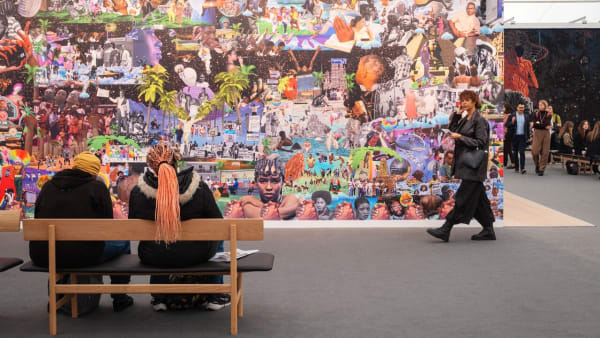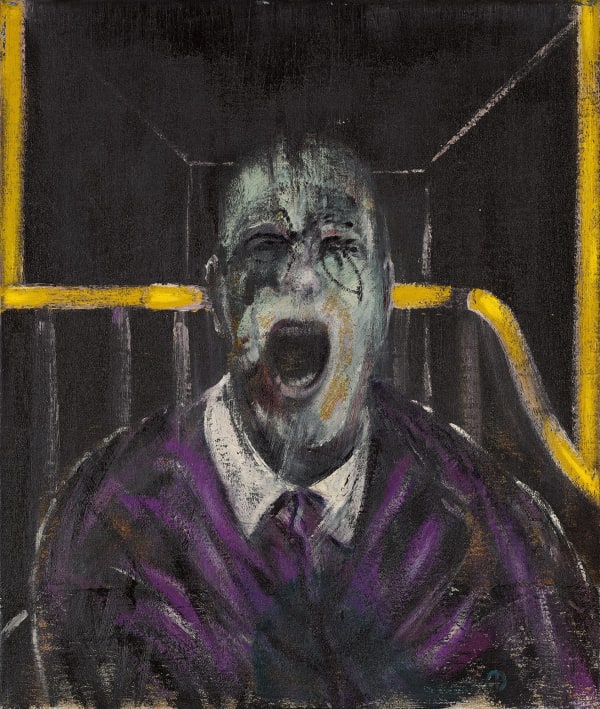-
Francis Bacon Prints For Sale.
Francis Bacon's art is a deep exploration of the human condition told through the revolutionary lens of a true genius. His distorted and contorted figures explore aspects religion, mythology & the deeply personal. Explore our latest Francis Bacon prints for sale at Guy Hepner, Bacon dealers since 2007.
Discover authentic Francis Bacon signed prints for sale below.
-
Works

Francis Bacon
Metropolitan Museum of Art, 1975Lithograph in colors on arches paper45 1/2 x 33 1/2 in
115.6 x 85.1 cmEdition of 200Copyright The ArtistFrancis Bacon’s Metropolitan Museum of Art (1975) lithograph encapsulates many of the defining themes and stylistic traits of his psychologically charged and viscerally unsettling body of work. Through a masterful...Francis Bacon’s Metropolitan Museum of Art (1975) lithograph encapsulates many of the defining themes and stylistic traits of his psychologically charged and viscerally unsettling body of work. Through a masterful juxtaposition of distorted human forms, abstracted environments, and haunting portraiture, Bacon constructs a scene steeped in ambiguity and emotional intensity. The tension in the composition stems from the interplay between fragmented, organic figures and a stark, geometric setting—an arena that feels simultaneously theatrical and claustrophobic.
The central space is dominated by a circular, stage-like platform that tilts precariously toward the viewer—a spatial distortion Bacon often employed to evoke psychological discomfort. This confined stage isolates the figures from any discernible natural context, emphasizing their entrapment in an existential void. The environment itself feels artificial and alienating, intensifying the sense of internal exile and emotional fragmentation that pervades the scene.
At its core, Metropolitan Museum of Art is a meditation on suffering, alienation, and the fractured human psyche. Bacon’s signature use of distortion and bodily disintegration reflects his belief in the instability of identity and the inherent chaos of the human condition. The contorted poses of the figures suggest a brutal physical and emotional struggle, capturing the body not as a unified whole but as a battlefield for invisible forces—trauma, violence, and existential dread.
The background is divided into three distinct zones: a central, pitch-black void flanked by two pale, ghostly portraits of men in suits. These figures, with their caricatured and elongated features, appear detached and spectral—more observers than participants. Their placement and expressionless gazes contribute to a sense of surveillance, as if they are judging or bearing silent witness to the central figures' suffering. The contrast between their pale forms and the enveloping darkness enhances the scene’s disquieting atmosphere.
Bacon amplifies the sense of theatricality through both composition and lighting. The stage-like platform, spotlighted against a shadowy backdrop, frames the central figures much like specimens or actors. This spectacle invites the viewer into a voyeuristic relationship with the scene, intensifying the feeling of exposure and estrangement. As with much of Bacon’s work, we are not merely observers but implicated witnesses to a spectacle of human vulnerability and distortion.
At the heart of the composition lies a kneeling, fleshy figure rendered with grotesque physicality. Its musculature is exaggerated, its form twisted and ambiguous, evoking both pain and exertion. The head hangs downward, and the limbs are so contorted that it becomes difficult to decipher the body’s orientation or intent. This ambiguity contributes to the overall psychological unease of the piece, as the figure hovers between motion and paralysis, torment and submission.
Bacon’s reduction of the body to a hybrid of raw flesh and abstract form is fully realized here. The figure is simultaneously hyper-physical and dehumanized—less a person than a shell or vessel caught in a moment of existential crisis. Its fragmentation underscores Bacon’s persistent concern with the fragility and impermanence of the human form, presenting the body as a site of both presence and disintegration.
In the foreground, a second figure lies sprawled at the edge of the stage. More amorphous and less distinctly human, this form appears almost animalistic, with a face resembling a melted mask or featureless blob. In contrast to the kneeling figure’s tense energy, this prone body seems inert, resigned, or even defeated. Yet there is a haunting connection between the two—perhaps a suggestion of duality, conflict, or co-dependence—hinting at an unresolved narrative of submission and struggle.
The flanking portraits reinforce the sense of exposure and judgment. Though their expressions are unreadable, their gaze appears to pierce through the composition, amplifying the painting’s themes of voyeurism and vulnerability. The viewer, too, becomes a participant in this unsettling exchange, cast in the role of a spectator complicit in the figures’ suffering. Bacon often played with this dynamic—his figures placed in psychologically charged spaces, observed and exposed, their pain both private and performative.
Ultimately, Metropolitan Museum of Art (1975) stands as a stark, haunting allegory of the human condition. Through spatial distortion, fragmented bodies, and ambiguous spectators, Bacon constructs a vision of psychological entrapment and corporeal anguish. It is a world of isolated figures under observation, their suffering laid bare—echoing Bacon’s enduring preoccupation with mortality, identity, and the brutal theatre of existence.
For more information on Francis Bacon’s Metropolitan Museum of Art or to buy Francis Bacon’s Metropolitan Museum of Art contact our galleries using the form below.Overview"The job of the artist is always to deepen the mystery".
Francis Bacon is one of the most important artists of the 20th century and post-war movements. Arguably one of the finest and most celebrated artists of his generation, Bacon holds a pivotal role in contemporary art through his revolutionary approach to his craft. One of the great explorers of the human condition Francis Bacon and his art, touch on fateful mix of mythology, religion, love and death, and document our joys, sorrows and pains perhaps better than any other artist before or since.
The imagery of Bacon is one of pure expression rejecting the prevailing artistic style of abstraction of the era, in favor of a distinctive and disturbing realism and his distorted forms convey a sense of both beauty and despair. The dichotomy in Bacon’s prints and imagery can be seen through his raw use of violent, yet delicate colors as well as the marriage he makes between the figurative and abstract. It is this soft balance between the brutal and the subtle, the violent and the soft and happiness and anguish that make Francis Bacon’s art so important and collectible. A master of painting, and known for his large scale canvases, Bacon combines seemingly disparate tectures, colours and forms to ceate a whirlwind of emotion conveying and reaching the heart of his subjective matter. Equally so Franci Bacon's print output, often as apres, lithographs or signed prints, offer his most popular subjects including Pope Francis and his famous triptychs.
Whether new to collecting Francis Bacon prints or an experienced collector, Guy Hepner can help. Since 2007 we have assisted clients across the world to buy Francis Bacon prints in confidence. Whether iconic triptych, lithographs or apres, our experienced and knowledgeable team are on hand to help you achieve your collecting goals. From our New York and London galleries, offer a wide selection of authentic Francis Bacon prints for sale.
Contact info@guyhepner.com for our latest Francis Bacon prints for sale or to buy Francis Bacon original art. News
News-

London’s Frieze Week Record Breakers
A Guide to a Blockbuster Week of Sales October 20, 2025London’s marquee auction houses just concluded a blockbuster week of contemporary art sales, coinciding with the Frieze art fair. In a series of evening auctions...Read more -

A Collector’s Guide to Francis Bacon Prints
Why Collect Bacon March 14, 2025Francis Bacon remains one of the most powerful and influential artists of the 20th century. His raw, visceral works depicting the human form in distorted,...Read more




